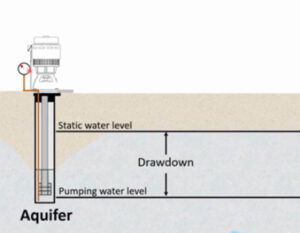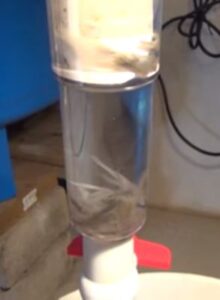The refilling rate depends on various factors. A healthy water well replenishes at a rate of 4-6 gallons per minute. The exact time to refill a water well depends on well depth, your usage pattern, underground water level, pump health, and well screen condition.
Factors which impact the Refilling Rate
Water Demands – The rate at which you withdraw water impacts the refilling rate. It will take longer to refill a water well with continuous withdrawal than one with random withdrawals. If your well is small and you pump a large volume of water, it will push the static level further down than anticipated during the construction phase. It will take more time to refill the well water.
Underground Water Level – The aquifer’s health from which well draws water also impacts refilling time. If you have tapped a reservoir with less water potential, it will take more time to refill. The size of the fracture on the surface of the rock also determines the speed at which water is coming out from it. Wells with a large rock and big fracture size refill quickly.

Aquifer Formation – The thickness of the aquifer formation, its hydro-conductivity, specific yield, and storage capacity also impact the time your well takes to refill.
Depth of the Well – The depth of the well is also a critical factor in deciding the refill rate. It has been observed that the depth of the well relative to the depth of the water table affects the refilling rate. You must dig your well at least 40-50 feet below the water table, so you never have to face a slow refilling or recovery rate.
Well Screen – A well screen is placed below the well casing. It is installed to trap sediment and allow water to enter your well. Over time, the well screen can get clogged due to sediment deposits. The best way to ensure that the refill rate is not affected due to a clogged well screen is to get your well inspected annually by well professionals. The driller will do a video inspection and highlight all the problems inside your well.

Slime Buildup – If there is bacteria slime build-up at the aquifer’s opening or well screen, it can also impact the refilling time. Slime will stop the flow of water and also alter the chemical properties of water. It may change the taste and give it a reddish color. Slime can be avoided by getting your water tested regularly and opting for the right treatment method.
Environmental Factors – Environmental factors like drought, less rainfall, and high temperature also affect the well refilling rate. Though their impact is very slow and may show after 8-10 years, they play a major role in deciding the well refilling rate.
Number of Wells on a Single Underground Source – It will take more time to refill your well if your neighbors are also using the same aquifer. This also decreases the water’s flow rate.
Final Words
It isn’t easy to calculate the exact refilling rate for a well. A lot of factors are in play here. If you want to get a fast refilling well, you must gather ground knowledge in detail and estimate your water usage, add a few gallons in it, and then decide the well’s depth and diameter. If you plan to construct a new well or do modifications to the existing one, make sure you follow all the state regulations and hire licensed well drillers.
